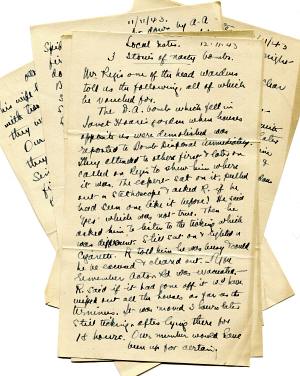LETTERS – HOLDING FAMILIES TOGETHER IN WORLD WAR II – Jerry Holmes
Ronn Robinson’s play brings thought about communication during WWII between soldiers on the front and those loved ones at home: letters provided the major link between them. These days with Skype, Facebook, and your handy news agencies that want to cover as many “particular truths” as they can find to boost ratings, many of those abroad are able to let those at home know where they are and often what they are doing.
Things were different in WWII when most communication carried restrictions as to what could be revealed, and even went through a censor. In THE COVER OF LIFE we have three wives living with the mother of their husbands who went off to join the service–different branches– the same day. In writing home, they devised a way to share the news: letters were available to the mother or any of the wives unless it had a heart drawn on the envelope, that symbol meant it was personal. News which was intended for one seldom remained private; this situation results in the major traumatic incident in the play.
Social historians have done a great deal of research and collection of letters from soldiers on the front, resulting in major exhibitions, publications, and video presentations. Many of the letters home are especially significant because they often got material past the censors describing incidents that those only at the front line knew about, but later became famous, or infamous. The variety of emotions and the ways in which those emotions are expressed offer lessons in dealing with the stress and anxiety of war.
A friend recently told me that a member of her family said that his wife always sent his letters in a certain shade of blue envelope so he could see his letter in the crowd. We can only imagine the importance of those away from home receiving letters. If some of you look through your boxes of memorabilia you might come across some letters written home from the front; that could be interesting.
Many of the letters sent and received ended relationships, some quite tragically. Apparently, at times women learned that they were widows from letters to friends even before the war department had the opportunity to officially notify them. The infamous “Dear John” letters received by troops triggered many intense psychological moments of betrayal by those who supposedly loved them.
Today, of course, we look back at the “quaintness” of people actually using “snail mail” to convey personal feelings; some will wonder how those folks got along without instant messaging with all the cute little symbols and videos. Well, the earlier generations did quite well. “The Cover of Life” demonstrates just what was necessary to keep communication and relationships alive. They actually helped keep families together during traumatic times.
Of course, letters were the important factor in all the times before now, when one can communicate rapidly and frantically the latest impulse, even with those servicemen and women stationed in remote areas. But, are there areas that are truly considered remote these days with all our technology to see the world, but unfortunately not to help us truly understand the world.


0 comments on “Letters – Holding Families Together in WW2”